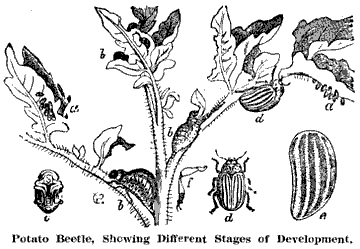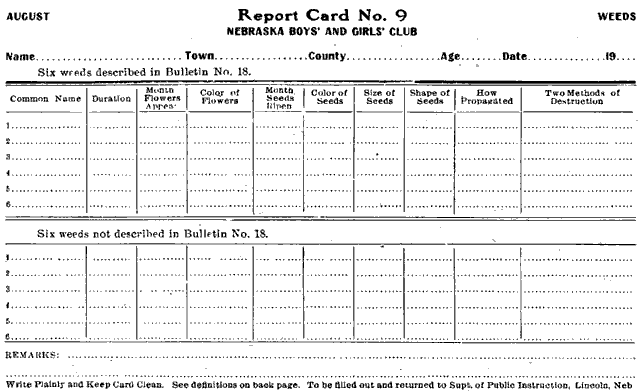NEGenWeb
Project
Resource Center
Schools
|
|
249 |
There is no insect that is so injurious to the potato crop as the potato beetle or "bug." The original home of this pest was doubtless the upper Mississippi Valley, although at the present time potato beetles are found in practically all potato-growing localities. It is so well known that a description seems hardly necessary. However, as it is often confused with the ladybug and blister beetle, the amateur potato grower may find a brief description helpful.
The potato beetle is about three-eighths of an inch long, very plump, being almost as wide as it is long. It is light yellow in color with ten black stripes running lengthwise of the wings. The larva are ugly, soft, slim creatures. They are dark red when first hatched but become lighter in color as they mature. There are generally two generations in one season, although some authorities have reported three. The beetles hibernate; that is, pass into the "resting" stage in the ground generally at a depth of eight or ten inches. They appear again early

in the spring. At this season they fly a great deal during the warmer part of the day. These flights generally take place before the potatoes appear above the ground. As soon as the potatoes are up the beetles' turn their attention to the tender sprouts. After a few days of feeding, the female deposits the eggs, which number from five hundred to one thousand in a single year. These eggs which usually hatch in from four to seven days are deposited on the underside of leaves. The larvae which pass through four stages, mature in from sixteen days to three Weeks, after which they pupate. They remain in the pupa stage about ten days.
The Colorado potato beetle has many natural enemies. Many insects, the most common of which is the ladybug, feeding on the larvae
|
250 |
|
and eggs. Quails, robins, crows, and many other birds destroy these pests by the millions each season. Chickens, ducks, skunks, snakes, and toads eat potato bugs with relish. However, these natural methods are not sufficient to completely control the beetle, and sprays are often resorted to in order to save the crop. A very effective spray can he made by mixing one pound of Paris green and one pound of lime with one hundred gallons of water. This solution should be applied with a hand sprinkler or a spray pump.
|
|
251 |

|
252 |
|
(For Report Card No. 9.)
This card should be filled out and returned to. the State Superintendent of Public Instructions Lincoln, Nebr., by September 1st.
1. DESCRIBE SIX WEEDS mentioned in Bulletin No. 18 and six not mentioned therein.
2. COMMON NAME--The name by which the weed is commonly known in your locality.
3. DURATION--Whether annual, biennial or perennial. For definition of these terms see Bulletin No. 18.
4. MONTH FLOWERS APPEAR--The first month that the weed blossoms in your locality. Some blossom for two or three months.
5. COLOR OF FLOWERS--Explains itself. A great many weeds have green flowers, which are not easily noticed.
6. MONTH SEEDS RIPEN--The month when the first seeds are ripe.
7. COLOR OF SEEDS--Explains itself.
8. SIZE OF SEEDS--In answering this question compare with some well known object as, bean, pin head, pea, radish seed, etc.
9 SHAPE OF SEEDS--Explains itself.
10. HOW PROPAGATED--Means how the plant reproduces itself or passes from one generation. to another, as by seeds, root stocks, taking root where the joints of the stem touch the ground, etc.
11. TWO METHODS OF DESTRUCTION--Explains itself.
 |
 |
 |
 |
|
© 2003 for the NEGenWeb Project by Ted & Carole Miller |
|||